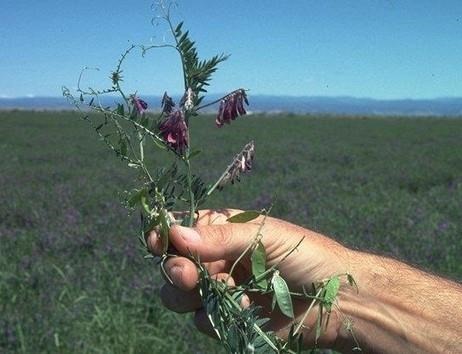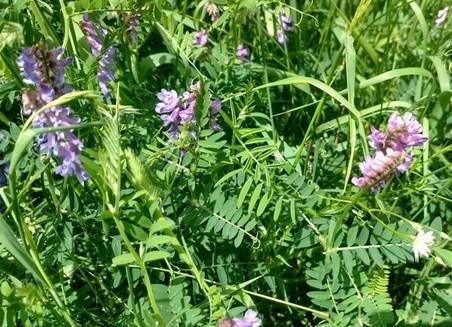By Rachael Freeman Long and Morgan Doran

Vetch (Vicia spp.) is growing like a weed everywhere this year, carpeting our hills with great swaths of purple flowers (see photo).
What is Vetch? There are several species that are commonly grown as crops, cover crops or weeds (see below table). Vetch a winter-hardy legume that's favored by early fall rains, which we had lots of last October (5.5-in in 24-hr in Sacramento). Vetch is also a nitrogen-fixing plant that works well as a cover crop in farming systems. It's also a good forage for bees and other pollinators and has extra floral nectaries (glands on stems that produce nectar) that attract beneficial insects like parasitoid wasps that prey on pests.
Is it a good livestock feed? Yes and No. As an annual leguminous vigorous herbaceous plant, vetch has high protein and relatively low fiber and reasonably high yields. It's vigorous growth and N fixing qualities is why it is so valuable as a cover crop, but it can also be grazed or fed as hay. Its quality is lower than that of alfalfa or clovers (protein levels from 15-20% depending upon stage of growth). It is commonly grown in mixes with small grains or grasses as a mix in different parts of the US. Vetch hay is difficult to handle due to the vine-like characteristics, and caution should be used due to anti-nutritional compounds and livestock palatability.

Vetch is sometimes grown with small grains, for example rye.
Anti-nutritional compounds. However, Vetch hay can cause serious (and potentially fatal) animal health problems, so is not recommended as a primary forage for horses and cows. Most of the anti-nutritional compounds are concentrated in the seeds, so immature harvests are recommended. Vetch seeds are poisonous; they contain cyanogenic glycosides and a diglucoside that can cause a neurologic disease. Although hairy vetch (V. villosa) and purple vetch (V. benghalensis) seed are the most toxic (being very closely related), other vetches have toxic seeds too, including common vetch (V. sativa). In addition, a toxin in vetch foliage is associated with a dermatitis or skin sensitivity disease, though this is extremely rare and not well understood. Most cases of vetch-induced dermatitis involve black cattle, such as Angus or Holstein, and horses can also be affected, so there may be specific susceptibility explained by a genetic predisposition. Lack of good information makes is difficult to assess vetch hay suitability for small ruminants like sheep, though there is anecdotal information that suggests it might be okay for goats.
How about rangelands? Vetch growing on grazing rangelands is actually a good, high-protein feed for livestock. In open range, cattle typically won't graze vetch until it dries down and seeds have shattered. On a hot day you can hear dry pods snap, crackle, and pop, like a bowl of Rice Krispies. Vetch is not favored by livestock when green due to low palatability (bitterness).
How about pastureland? Fenced pastures loaded with vetch going to seed could spell trouble for horses and cows, especially if there is little else to eat. Toxicity risk can be alleviated by ensuring other forage options are available and by stocking animals at very low densities and giving them the option to selectively consume non-toxic plants and avoid toxic plants. Again, once the plant has dried down and seeds have shattered (detached and fallen), it should be okay as grazing feed.
How big a problem is vetch toxicity? The California Animal Health and Food Safety Laboratory at UC Davis has had a few cases of vetch toxicity to cattle and horses over the years, but not many. It's still unclear if this means few cattle are exposed to vetch or few cattle actually develop disease. It's still kind of a mystery as to why vetch is sometimes a problem and other times not. It might be a matter of the degree of its presence in animal diets – low percentage is okay, high percentage more problematic. "Dose makes the poison" as a toxicologist would say.
How about croplands? Oats and vetch used to be a popular mix for feed, but not anymore and hay growers try to keep it out of their forage crops. If cereal grains are in a crop rotation, vetch seed is about the same size as wheat and barley kernels, making it hard and expensive to separate during seed cleaning. Vetch is also hard-seeded, meaning seed can lie in the ground dormant for years and germinate when not wanted, though the viability for most seed is about 5 years, allowing opportunities for management. For control, one can mow prior to pod and seed set or use broadleaf or pre-emergent herbicides if needed.
Vetch identification. To differentiate different species of vetch one needs to look at the flowers. Common vetch (V. sativa) has flowers with a short stalk (peduncle), meaning the flowers are attached close to the stem from where it originates (picture). Hairy vetch (V. villosa), purple vetch (V. benghalensis), and American vetch (V. americana) all have flowers with long stalks. Hairy and purple vetch flowers are aligned on one side of the flower axis (picture) whereas American vetch flowers are more upright (picture). Purple vetch will generally have flowers about the same size as the leaflets (picture), while the flowers on hairy vetch are generally larger or longer than the leaflet (picture).
What types of vetch are found around California on agricultural and rangelands? According to Dr. Alison Colwell, curator, UC Davis Herbarium, following are the rankings of vetch (Vicia) species abundance by county. This information comes from the Consortium of California Herbaria (cch2.org). The data are from all years that collections were made, which is basically the past 100 years. The take-home point of this analysis is that there are several similar vetch species that are all spottily dominant around California.
Yolo County (all ag)
1. V. villosa (hairy; lana/woollypod subsp. varia)
2. V. sativa (common)
3. V. benghalensis (purple)
Mariposa County (mostly ranch/public land, central)
1. V. americana (American vetch; native plant)
2. V. sativa
3. V. benghalensis
Butte County (part ag, part ranch, north)
1. V. villosa
2. V. sativa
3. V. americana
Tulare County (ag, arid, south)
1. V. americana
3-way tie for third place, with 3 each: V. benghalensis, V. sativa and V. villosa.
Stanislaus County (ag, central)
1. V. villosa
2. V. sativa
3. V. americana
Source : ucanr.edu